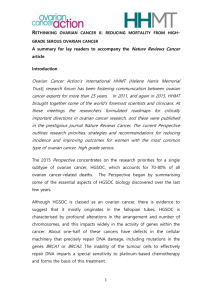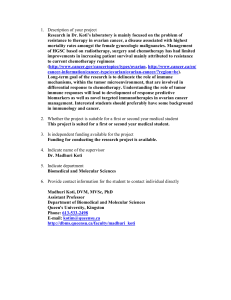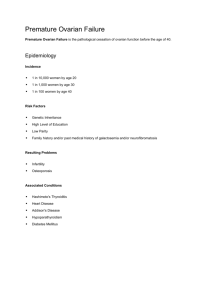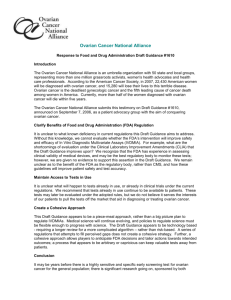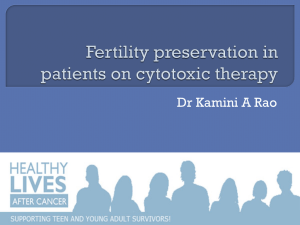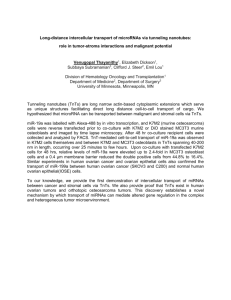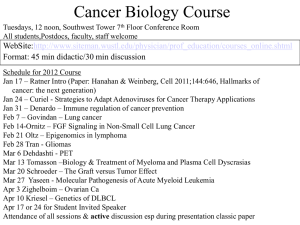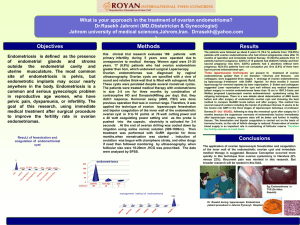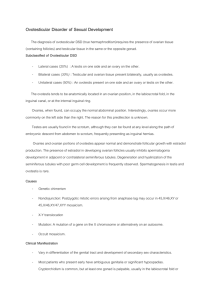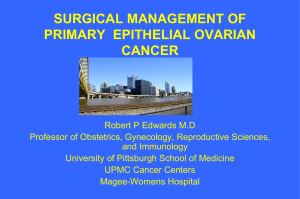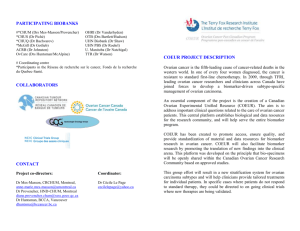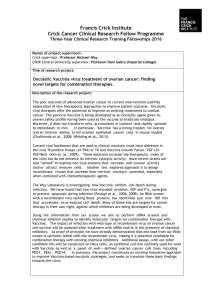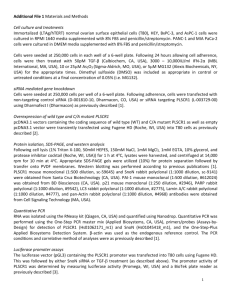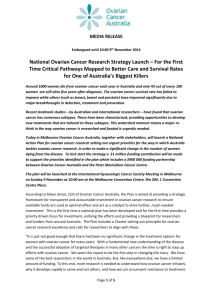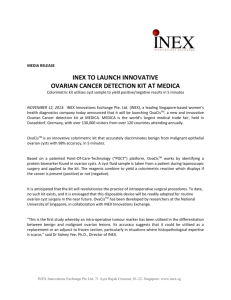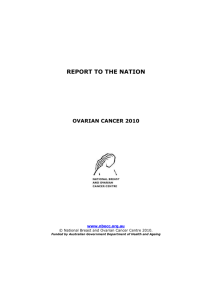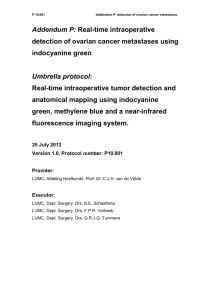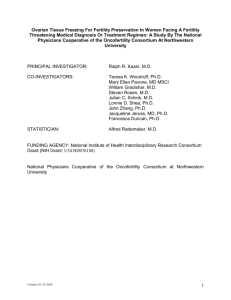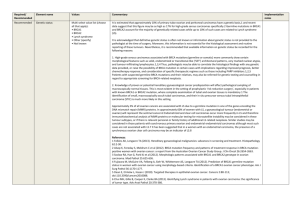Rethinking ovarian cancer ii
advertisement
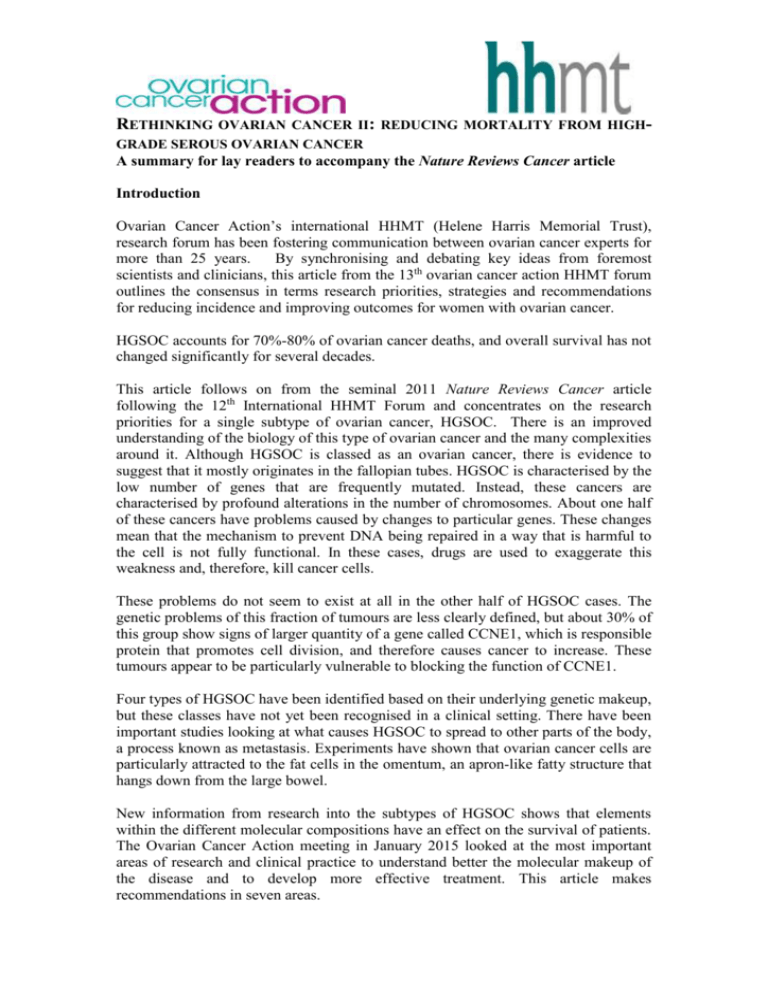
RETHINKING OVARIAN CANCER II: REDUCING MORTALITY FROM HIGHGRADE SEROUS OVARIAN CANCER A summary for lay readers to accompany the Nature Reviews Cancer article Introduction Ovarian Cancer Action’s international HHMT (Helene Harris Memorial Trust), research forum has been fostering communication between ovarian cancer experts for more than 25 years. By synchronising and debating key ideas from foremost scientists and clinicians, this article from the 13th ovarian cancer action HHMT forum outlines the consensus in terms research priorities, strategies and recommendations for reducing incidence and improving outcomes for women with ovarian cancer. HGSOC accounts for 70%-80% of ovarian cancer deaths, and overall survival has not changed significantly for several decades. This article follows on from the seminal 2011 Nature Reviews Cancer article following the 12th International HHMT Forum and concentrates on the research priorities for a single subtype of ovarian cancer, HGSOC. There is an improved understanding of the biology of this type of ovarian cancer and the many complexities around it. Although HGSOC is classed as an ovarian cancer, there is evidence to suggest that it mostly originates in the fallopian tubes. HGSOC is characterised by the low number of genes that are frequently mutated. Instead, these cancers are characterised by profound alterations in the number of chromosomes. About one half of these cancers have problems caused by changes to particular genes. These changes mean that the mechanism to prevent DNA being repaired in a way that is harmful to the cell is not fully functional. In these cases, drugs are used to exaggerate this weakness and, therefore, kill cancer cells. These problems do not seem to exist at all in the other half of HGSOC cases. The genetic problems of this fraction of tumours are less clearly defined, but about 30% of this group show signs of larger quantity of a gene called CCNE1, which is responsible protein that promotes cell division, and therefore causes cancer to increase. These tumours appear to be particularly vulnerable to blocking the function of CCNE1. Four types of HGSOC have been identified based on their underlying genetic makeup, but these classes have not yet been recognised in a clinical setting. There have been important studies looking at what causes HGSOC to spread to other parts of the body, a process known as metastasis. Experiments have shown that ovarian cancer cells are particularly attracted to the fat cells in the omentum, an apron-like fatty structure that hangs down from the large bowel. New information from research into the subtypes of HGSOC shows that elements within the different molecular compositions have an effect on the survival of patients. The Ovarian Cancer Action meeting in January 2015 looked at the most important areas of research and clinical practice to understand better the molecular makeup of the disease and to develop more effective treatment. This article makes recommendations in seven areas. 1. Develop better experimental models Many of the current cancer cell lines (cancer cells grown in culture for laboratory experiments) have proven unsuitable for further study and it is recommended that new ones should be developed, which more accurately represent this cancer. The experimental conditions should also mimic physical the conditions that surround the tumour, known as the tumour microenvironment (TME). Samples from patients’ tumours should also be incorporated into further experiments. 2. Exploit immune responses and interaction with other TME cells Our bodies have a mechanism that recognizes threats and that acts to defend itself against foreign and harmful bodies. This is known as the immune response. Patients’ own immune response to HGSOCs varies; studies have clearly shown that patients who have a strong immune response are more likely to do better than those who don’t. A future aim of research is to try to discover what drives this immune response and consequently how to use it to a patient’s advantage. In order to predict outcomes and provide a means of determining the best therapy, it would be useful to develop criteria to characterise each individual’s immune response, using a model developed from colorectal cancer, known as an ‘immunoscore’. Such detailed characterisation would identify particular areas of strength or weakness in an individual’s immune response and could therefore lead to tailored immune therapies to overcome the weaknesses. In addition to its immune cells, the tumour microenvironment also influences treatment responses in different ways, so it is proposed to look at how it is affected by chemotherapy and the administration of drugs. 3. Prioritise the understanding of the biology of the disease and its recurrence; and of exceptional-responders The success of chemotherapy in controlling the disease varies considerably between patients. The reason behind this needs to be better understood. Samples from patients whose disease has returned and from those whose cancer is at the final stage should be analysed to discover the reason for their increased resistance to drug treatment. In contrast, some patients have what is known as an exceptional response to treatment and it is also important to look at the reasons for super responders, so that such understanding could then be used to help patients who respond less well. 4. Transition to clinical trials of HGSOC types It is advocated that there should be a move towards clinical trials that are divided into groups according to the different molecular types of this cancer. In addition, the effect of new drugs on the cancer should be analysed. Clinical trials should be expanded to include the analysis of these new drugs following recurrence of the disease. Performing a laparoscopy (keyhole surgery) for confirming the diagnosis would help in obtaining valuable information about the spread of the disease in the abdominal cavity. Samples could then be taken which would then be used to determine whether to use undertake surgery first or at a later stage, after some chemotherapy. 5. Implement strategies that could make a rapid impact on prevention and clinical care Risk of ovarian cancer cannot be reduced through lifestyle choices, unlike some other cancers. We need to find ways to diagnose this disease in its early stages, as before it spreads into the abdomen it often does not have any symptoms. Research should also be conducted into prevention strategies including the efficacy of the removal of the fallopian tubes alone and / or the ovary. It has been shown that oral contraceptives provide an effective means of reducing the risk of this cancer; and it is recommended that this information should be more widely advertised. These strategies are particularly important for women at risk of hereditary ovarian cancer. The use of current low toxicity drugs in new ways should also be more widespread. For example, studies have indicated that regular use of aspirin, or the diabetes drug metformin, to treat non-cancer conditions has the additional benefit of increasing survival rates of women with HGSOC. More experiments should be undertaken to confirm these findings. 6. Better define the value of surgical reduction of the tumour Another recommendation is to look into the value of using chemotherapy for patients at an advanced stage of the disease. Researchers should also look at finding indicators to determine the best time to undertake surgery, including by using laparoscopy to assess a patient’s suitability for surgery. Re-examining a patient by laparoscopy to check for signs of the disease at the end of primary treatment should also be considered as personalised treatment options could be instigated to prevent the recurrence of the tumour. 7. Move from ‘parts list’ to integrated view We need to examine the disease as a whole through a better understanding of its individual components, by using samples obtained from patients who have a primary cancer, and those whose disease has returned. Conclusion This disease currently kills approximately 150,000 women worldwide each year and survival rates have shown only the smallest improvement over many years. The conclusion of the Ovarian Cancer Action HHMT 13th International Forum was that research into the origins, spread and nature of HGSOC should be more thorough and more collaborative than it has been in the past. If this can be achieved, then there is a good chance that the number of cases of this cancer can be reduced and that the survival of those who are affected will be improved. <ENDS> Author: Penny Berry WIMM Oncology Administrator Molecular Oncology Laboratories University Department of Medical Oncology Weatherall Institute of Molecular Medicine John Radcliffe Hospital Oxford OX3 9DS Email: penny.berry@imm.ox.ac.uk Tel: (0)1865 222 458 or 617 435 Fax: (0)1865 222 431
